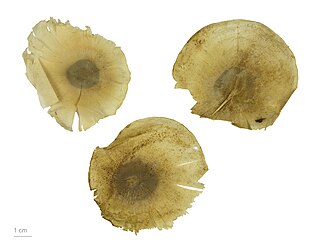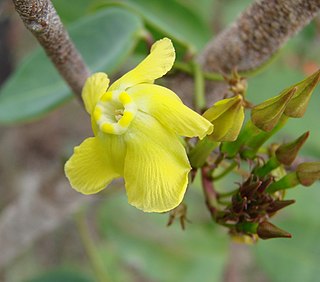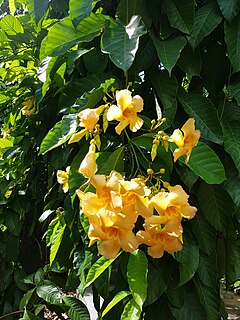| Himatanthus | |
|---|---|
 | |
| Himatanthus bracteatus | |
| Scientific classification | |
| Kingdom: | Plantae |
| (unranked): | Angiosperms |
| (unranked): | Eudicots |
| (unranked): | Asterids |
| Order: | Gentianales |
| Family: | Apocynaceae |
| Genus: | Himatanthus Willd. ex Schult. |
Himatanthus is a genus of flowering plant in the family Apocynaceae, first described as a genus in 1819. It is native to Panama and South America. [1] [2] [3] [4]
A genus is a taxonomic rank used in the biological classification of living and fossil organisms, as well as viruses, in biology. In the hierarchy of biological classification, genus comes above species and below family. In binomial nomenclature, the genus name forms the first part of the binomial species name for each species within the genus.

The flowering plants, also known as angiosperms, Angiospermae or Magnoliophyta, are the most diverse group of land plants, with 64 orders, 416 families, approximately 13,164 known genera and c. 369,000 known species. Like gymnosperms, angiosperms are seed-producing plants. However, they are distinguished from gymnosperms by characteristics including flowers, endosperm within the seeds, and the production of fruits that contain the seeds. Etymologically, angiosperm means a plant that produces seeds within an enclosure; in other words, a fruiting plant. The term comes from the Greek words angeion and sperma ("seed").
Family is one of the eight major hierarchical taxonomic ranks in Linnaean taxonomy; it is classified between order and genus. A family may be divided into subfamilies, which are intermediate ranks between the ranks of family and genus. The official family names are Latin in origin; however, popular names are often used: for example, walnut trees and hickory trees belong to the family Juglandaceae, but that family is commonly referred to as being the "walnut family".
- Species [5]
- Himatanthus articulatus (Vahl) Woodson - widespread from Panama east to French Guiana and south to Bolivia
- Himatanthus attenuatus (Benth.) Woodson - Venezuela, Colombia, N Brazil
- Himatanthus bracteatus (A.DC.) Woodson - Venezuela, Colombia, Guianas, Brazil, Peru, Ecuador
- Himatanthus drasticus (Mart.) Plumel - Guianas, Brazil
- Himatanthus lancifolius (Müll.Arg.) Woodson
- Himatanthus obovatus (Müll.Arg.) Woodson - Brazil, Bolivia, Guyana
- Himatanthus phagedaenicus (Mart.) Woodson - S Venezuela, NW Brazil
- Himatanthus semilunatus Markgr. - Amazon Basin
- Himatanthus stenophyllus Plumel - Colombia, NW Brazil, Guyana, Suriname
- Himatanthus tarapotensis (K.Schum. ex Markgr.) Plumel - Colombia, Bolivia, Brazil, Peru, Ecuador





